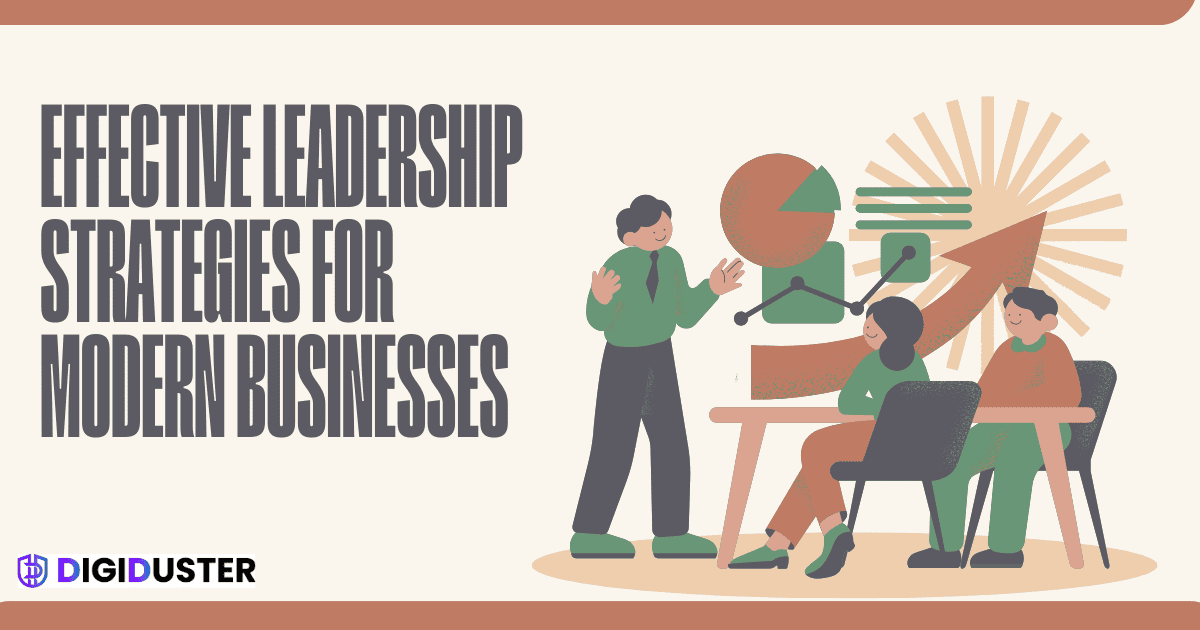Effective leadership is more crucial than ever in the highly dynamic business competitive landscape that exists today. A command-and-control method of managing will no longer be in the contemporary business environment as being a leader today also means building and fostering an innovation/growth-driven culture. Leaders need to be nimble, creative when solving complex problems, and influential with all kinds of stakeholders working towards common organizational goals. In the following, we´ll take a look at some of the most important tactics that today´s leaders can use to steer their businesses in the right direction. Let’s cover the effective leadership strategies for modern businesses.
1. Be Adaptive and Agile
The business environment today is ever-changing with new technology, updated market needs, and sophisticated customer behaviour. adopt adaptability as the core meta-strategy of leadership. Agility allows leaders to change direction and remain successful — in terms of market shifts or economic downturns, rapid technological changes amidst businesses are critical.
Agile leaders respond to change and create changes. They create a culture around continuous learning and innovation, which gives employees inspiration to experiment and think of new ideas. This flexibility allows businesses to have a fighting chance and not remain fragile in volatile times.
Example:
Consider how companies like Amazon have adapted to changing consumer behaviours. Jeff Bezos, as a leader, pushed the company to continuously evolve from an online bookstore to a global e-commerce and cloud computing powerhouse by staying agile and encouraging innovation at every level.
2. Creating a Compelling Vision and Purpose
Successful leaders have a clear vision that provides direction and purpose for the entire organization. A well-communicated vision helps unify the team and motivates employees to work towards shared goals.
A Vision is more than just setting goals. The point of Reference Architecture is to create and drive energy and commitment into the organization. A great vision will make sure that employees are working towards the same goals, and help motivate them to contribute all they can.
Example:
Apple, under the leadership of Steve Jobs, excelled because of Jobs’ ability to communicate a vision of innovative and user-friendly technology. that this vision set out to change industries and improve lives for the people. It was under his leadership that Apple became a giant in design and technology.
3. Inclusive Collaboration and Empowerment
In modern business, collaboration is key. Leaders who encourage a culture of teamwork and shared responsibility can foster innovation and problem-solving. Collaborative environments uplift diversity of perspectives that get creativity into songs and ensure organizations better handle complicated problems.
See also: Ethical Hacking: Roles & Importance of Certified Ethical Hackers
Empowerment goes hand-in-hand with collaboration. Leaders should delegate and trust their teams to make decisions while providing the tools & support necessary for success. By empowering employees you build confidence, drive accountability and improve performance.
Example:
Google There we find a culture of collaboration where employees have autonomy and responsibility for what they are doing. Through its 20% time initiative, which lets employees spend a few hours each week on personal projects outside of their assigned workstreams — and led to the creation of some of Google’s most groundbreaking products including Gmail.
4. Empathy And Emotional Intelligence
Emotional Intelligence (EI) is probably one of the most important skills for leaders in this era. Leaders with high EI can identify and regulate their emotions. Not only do they have empathy — the ability to more deeply understand and share another person’s feelings, building deeper relationships with their teams;
Empathetic leadership can build trust and loyalty in teams. These leaders are significantly more skilful at navigating difficult conversations, delivering effective feedback and empowering their teams to operate under duress or ambiguity Especially with the increasing presence of remote work and flexible arrangements, leaders who show empathy are better equipped to keep top performers while maintaining a positive working environment.
Example:
Satya Nadella, CEO of Microsoft, is widely recognized for transforming the company’s culture by emphasizing empathy and emotional intelligence. Nadella’s leadership style has been credited with reinvigorating Microsoft, making it more innovative and collaborative, and allowing it to compete more effectively in the modern tech landscape.
5. Data-Driven Decision Making
In the age of big data, leaders can no longer rely solely on intuition when making decisions. Modern leaders leverage data to drive their decision-making processes, ensuring that their choices are backed by solid evidence and analysis.
It allows organizations to easily spot trends, consumer preferences as well helps in fine-tuning the operations. Nevertheless, data should be juxtaposed with human insights. Data is helpful in that it can provide a good basis for our decisions, but leaders must also take into context and the people within their environment.
Example:
Think of companies like Netflix that make use of data to drive their decision-making. Netflix gathers tremendous data on what kinds of shows their customers like to watch, and which ones they might be interested. This approach has played a significant role in Netflix’s success as a global streaming giant.
6. Champion Diversity and Inclusion
Diversity and inclusion are not just trendy buzzwords — they’re a critical piece of any successful business. We know today that not only is Diversity and Inclusion the moral thing to do, but diverse teams introduce a myriad of outlooks, thoughts and life experiences which in any proactive sense should promote better leadership decision-making capability alongside innovation.
See also: A Comparative Analysis of Cybersecurity & Information Security
Leaders function to create an inclusive environment where everyone feels valued and can bring a valuable perspective to the table. To this end, they are responsible for creating equity policies, mentorship programs, and hiring strategies that reflect a deep investment in diversity. Championing diversity and inclusion can help leaders establish a more innovative, resilient organization.
Example:
Salesforce, led by CEO Marc Benioff has been an outspoken voice for inclusivity and diversity. It has introduced a number of initiatives to tackle the gender pay gap, bolster diversity among its top ranks and create an inclusive working environment.
7. Invest in Continuous Learning and Development
For the same, we are required to learn continuously and that becomes very important in this fast-paced business era. Leaders should be focused on the professional development of their employees by offering chances to learn new things and evolve in what they are doing. Leaders who invest in learning and developing their people, keep them competitive.
Modern leaders should also lead by example when it comes to continuous learning. By demonstrating a commitment to personal and professional growth, leaders inspire their teams to do the same.
Example:
IBM has long been a leader in employee development. The company offers extensive training and development programs, encouraging employees to continuously upgrade their skills. IBM’s leadership believes that investing in its workforce is key to remaining competitive in the rapidly evolving tech industry.
8. Lead with Integrity and Transparency
In great leadership, effective actions are the result of trust. Those leaders who behave with integrity and show transparency in their actions/decisions are naturally going to win the trust of their team or stakeholders. But leaders have to be above board today and hold themselves accountable — so that others will, too.
That transparency also covers communication, Leaders need to be speaking with their teams, informing employees what is going on and why it matters for the company. This transparency breeds trust, lifts spirits and ensures everyone is pulling in the right direction for what they want to achieve.
Example:
Patagonia, led by founder Yvon Chouinard, is known for its commitment to ethical business practices. The company is transparent about its environmental impact and works to minimize its footprint, even when it means sacrificing profits. This integrity has built a loyal customer base and set Patagonia apart as a leader in sustainable business practices.
In conclusion, effective leadership in modern businesses requires a combination of adaptability, emotional intelligence, collaboration, and a strong sense of purpose. By embracing these strategies, leaders can inspire their teams, foster innovation, and drive sustainable success in a rapidly changing world.



